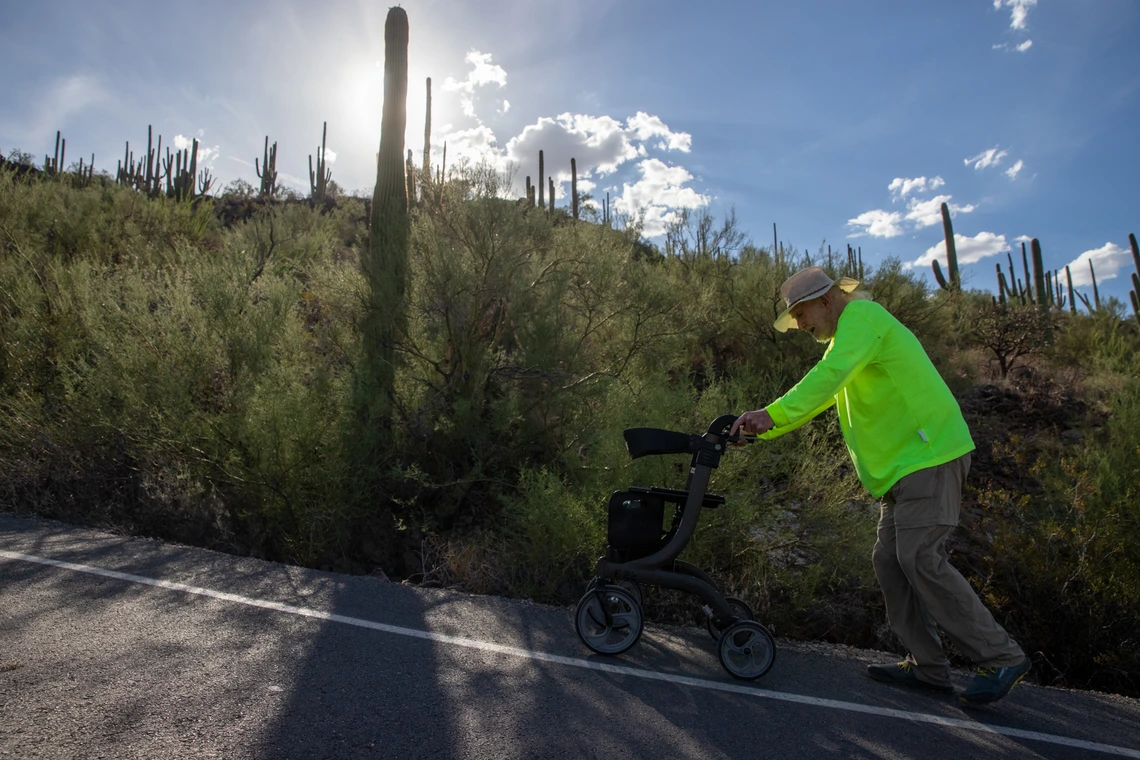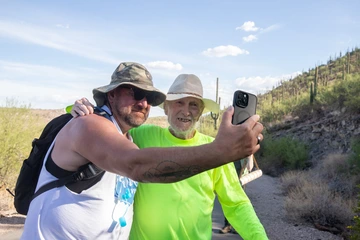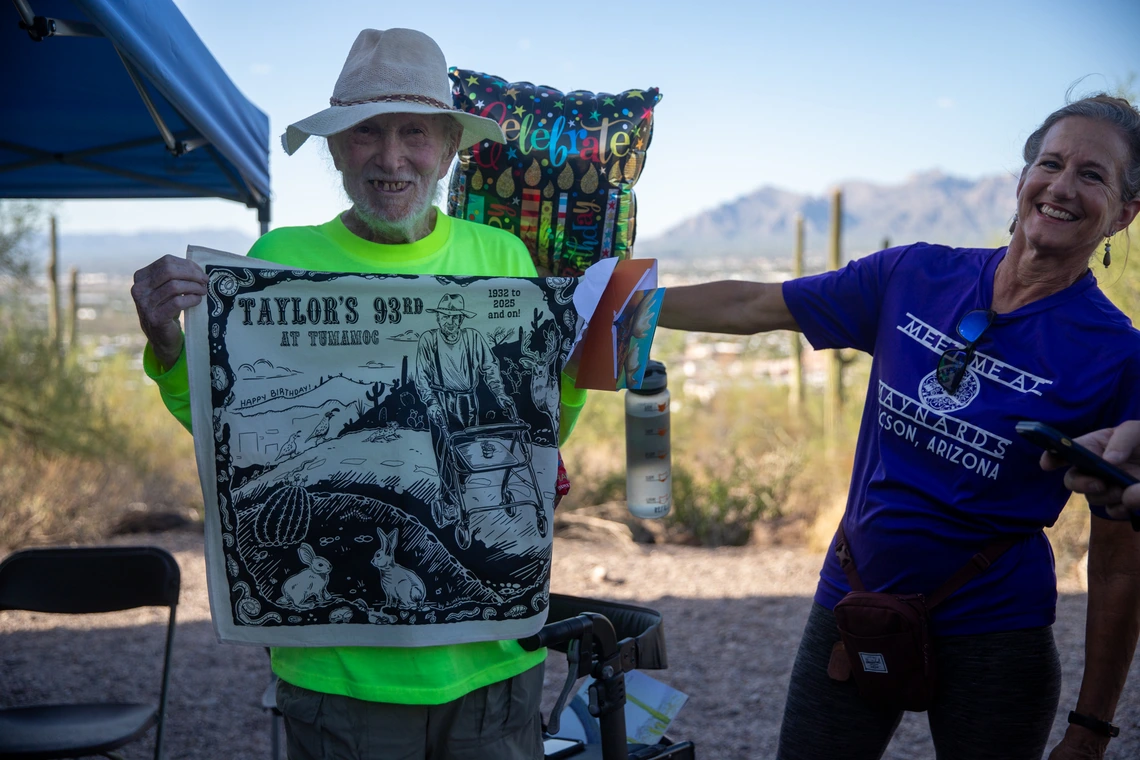Taylor Moore, 93, finds community and 'grit' hiking Tumamoc Hill

Taylor Moore has hiked Tumamoc Hill nearly every Monday, Wednesday and Friday for several years. Staffers from the U of A's Desert Laboratory at Tumamoc Hill held a small gathering on Monday to celebrate Moore's 93rd birthday, welcoming about 50 fellow hikers and Moore's family and friends.
Kyle Mittan/University Communications
Hike Tumamoc Hill enough times on a regular schedule and you're bound to get to know other regular hikers. And in the dead of summer, only the most committed make it out for the evening hikes.
At about 4:30 p.m. on Monday, near the hottest point of a 107-degree Tucson summer day, the hill was deserted. But of the few who were out there, they all seemed to know – or know about – Taylor Moore.
Moore has hiked the hill nearly every Monday, Wednesday and Friday for several years, since the COVID pandemic began to ebb. He stands out as he makes his way up the hill's paved pathway, often sporting a fluorescent green shirt and pushing a walker.
And as of Monday, Moore is 93 years old. The regular walks, he said, keep him healthy.

Many fellow Tumamoc walkers stopped to wish Moore a happy birthday during his hike on Monday and called him an inspiration.
Kyle Mittan/University Communications
"If I don't walk Tumamoc, I can't sleep. When I walk Tumamoc, I get a good night's sleep and I wake up in the morning feeling like a million bucks," Moore said on Monday, after trudging up much of the hill. "I'm addicted to Tumamoc."
Many locals know Moore's addiction. The hill near North Silverbell and West Anklam roads on Tucson's west side is best known for its 1.5-mile walking path that takes about 1,000 visitors each day up to a roughly 700-foot summit. Tumamoc has been continuously stewarded by humans for more than 4,000 years, and is a prominent cultural site for the Tohono O'odham, who call the hill Cemamagi Du'ag (pronounced CHE-ma-mak doh-ahk), or Horned Lizard Mountain.
The hill is also home to the Desert Laboratory on Tumamoc Hill, a 122-year-old research facility where arid-land ecology was born, which the University of Arizona has managed since 1956. The Arizona Institute for Resilience now manages the lab, and the 830-acre preserve surrounding it, in partnership with Pima County.
Staffers from the hill held a small gathering on Monday to celebrate Moore's birthday, welcoming about 50 fellow hikers and Moore's family and friends, including many from his native El Paso, Texas.
Erin Tanaka, a program coordinator who manages much of the Desert Lab's programming, has seen Moore regularly since she started working on the hill three years ago. After many smiles and waves, Tanaka introduced herself and got to know Moore over the last year.
"Taylor just exudes this joy when you speak with him, and he's such an inspiration," Tanaka said.
Moore overcame polio as a child and went on to fly fighter jets in the U.S. Air Force from 1953 to 1957. He then went to law school and spent his career practicing civil litigation in Texas. He moved to Tucson in 2013 after frequent visits from El Paso to visit his daughter and other family who lived here. In retirement, Moore was drawn to volunteering, especially for causes that served children and took him outdoors.
When Tanaka asked if Moore would be willing to share his story and experiences as a Tumamoc regular for a write-up in the Arizona Institute for Resilience newsletter, the plans grew into the small, one-off birthday gathering on Monday.

Friends of Moore's brought freebies to commemorate his birthday – including stickers and handkerchiefs depicting his Tumamoc treks.
Kyle Mittan/University Communications
"Once you start walking Tumamoc, there are so many things to get you excited about it," Moore said, especially the learning opportunities for children. "I think I've been all over the world pretty much, and I don't think there's anything that's a better classroom. If you want problem solvers, bring them to Tumamoc."
Robert Villa, a community outreach assistant for the Desert Lab, said Moore's experience exemplifies what Villa describes as Tumamoc's role as "the Central Park of Tucson."
"We're here to guide the university's investment in the hill in the best possible way, to harness the sense of place here," Villa said. "What Taylor gets out of it is one thing, but it's different for different people, and that's both an opportunity and a challenge to unify people in a chaotic world. We just hope to guide a collective sense of ownership in a way that everyone feels welcome."
Moore, speaking as a Tumamoc veteran, said there's one word that unites all regular walkers: grit. It's an increasingly important trait, he pointed out, for anyone who wants to make the world a better place.
"When you look around and you want people to help you in that endeavor, you're looking for grit," he added. "You're going to find it at Tumamoc."
For more information about events at Tumamoc – including the upcoming Tumamoc Hill Youth Program and Wildlife Extravaganza, which both begin in September – visit the Desert Lab's calendar of public events.





